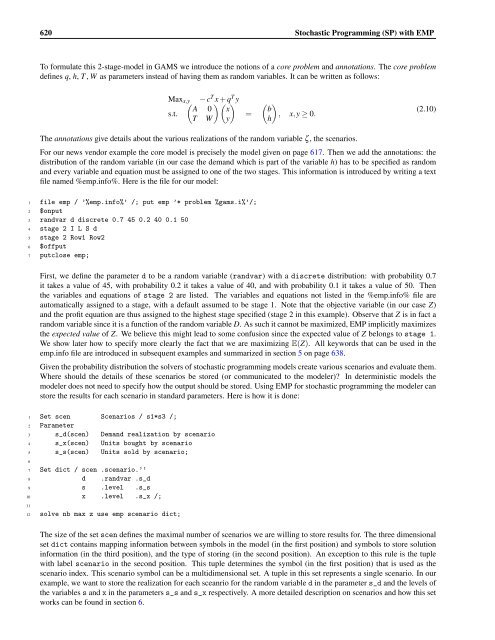Stochastic Programming (SP) with EMP - Gams
Stochastic Programming (SP) with EMP - Gams
Stochastic Programming (SP) with EMP - Gams
Create successful ePaper yourself
Turn your PDF publications into a flip-book with our unique Google optimized e-Paper software.
620 <strong>Stochastic</strong> <strong>Programming</strong> (<strong>SP</strong>) <strong>with</strong> <strong>EMP</strong><br />
To formulate this 2-stage-model in GAMS we introduce the notions of a core problem and annotations. The core problem<br />
defines q, h, T , W as parameters instead of having them as random variables. It can be written as follows:<br />
Maxx,y − cT x + qT y<br />
A 0 x<br />
s.t.<br />
T W y<br />
=<br />
<br />
b<br />
, x,y ≥ 0.<br />
h<br />
The annotations give details about the various realizations of the random variable ζ , the scenarios.<br />
For our news vendor example the core model is precisely the model given on page 617. Then we add the annotations: the<br />
distribution of the random variable (in our case the demand which is part of the variable h) has to be specified as random<br />
and every variable and equation must be assigned to one of the two stages. This information is introduced by writing a text<br />
file named %emp.info%. Here is the file for our model:<br />
1 file emp / ’%emp.info%’ /; put emp ’* problem %gams.i%’/;<br />
2 $onput<br />
3 randvar d discrete 0.7 45 0.2 40 0.1 50<br />
4 stage 2 I L S d<br />
5 stage 2 Row1 Row2<br />
6 $offput<br />
7 putclose emp;<br />
First, we define the parameter d to be a random variable (randvar) <strong>with</strong> a discrete distribution: <strong>with</strong> probability 0.7<br />
it takes a value of 45, <strong>with</strong> probability 0.2 it takes a value of 40, and <strong>with</strong> probability 0.1 it takes a value of 50. Then<br />
the variables and equations of stage 2 are listed. The variables and equations not listed in the %emp.info% file are<br />
automatically assigned to a stage, <strong>with</strong> a default assumed to be stage 1. Note that the objective variable (in our case Z)<br />
and the profit equation are thus assigned to the highest stage specified (stage 2 in this example). Observe that Z is in fact a<br />
random variable since it is a function of the random variable D. As such it cannot be maximized, <strong>EMP</strong> implicitly maximizes<br />
the expected value of Z. We believe this might lead to some confusion since the expected value of Z belongs to stage 1.<br />
We show later how to specify more clearly the fact that we are maximizing E(Z). All keywords that can be used in the<br />
emp.info file are introduced in subsequent examples and summarized in section 5 on page 638.<br />
Given the probability distribution the solvers of stochastic programming models create various scenarios and evaluate them.<br />
Where should the details of these scenarios be stored (or communicated to the modeler)? In deterministic models the<br />
modeler does not need to specify how the output should be stored. Using <strong>EMP</strong> for stochastic programming the modeler can<br />
store the results for each scenario in standard parameters. Here is how it is done:<br />
1 Set scen Scenarios / s1*s3 /;<br />
2 Parameter<br />
3 s_d(scen) Demand realization by scenario<br />
4 s_x(scen) Units bought by scenario<br />
5 s_s(scen) Units sold by scenario;<br />
6<br />
7 Set dict / scen .scenario.’’<br />
8 d .randvar .s_d<br />
9 s .level .s_s<br />
10 x .level .s_x /;<br />
11<br />
12 solve nb max z use emp scenario dict;<br />
The size of the set scen defines the maximal number of scenarios we are willing to store results for. The three dimensional<br />
set dict contains mapping information between symbols in the model (in the first position) and symbols to store solution<br />
information (in the third position), and the type of storing (in the second position). An exception to this rule is the tuple<br />
<strong>with</strong> label scenario in the second position. This tuple determines the symbol (in the first position) that is used as the<br />
scenario index. This scenario symbol can be a multidimensional set. A tuple in this set represents a single scenario. In our<br />
example, we want to store the realization for each sceanrio for the random variable d in the parameter s_d and the levels of<br />
the variables s and x in the parameters s_s and s_x respectively. A more detailed description on scenarios and how this set<br />
works can be found in section 6.<br />
(2.10)

















